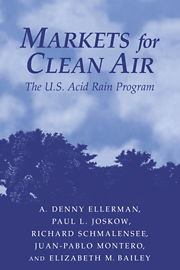Book contents
- Frontmatter
- Contents
- List of Illustrations
- List of Tables
- Preface
- Acknowledgments
- Part I Background
- Part II Compliance and Trading
- 5 Title IV Compliance and Emission Reductions, 1995–97
- 6 Emissions Trading: The Effect on Abatement Behavior
- 7 Emissions Trading: Development of the Allowance Market
- 8 Title IV's Voluntary Compliance Program
- 9 Cost of Compliance with Title IV in Phase I
- Part III Questions and Implications
- Appendix: Effect of Title IV on SO2 Emissions and Heat Input by Susanne M. Schennach
- Bibliography
- Index
5 - Title IV Compliance and Emission Reductions, 1995–97
Published online by Cambridge University Press: 10 December 2009
- Frontmatter
- Contents
- List of Illustrations
- List of Tables
- Preface
- Acknowledgments
- Part I Background
- Part II Compliance and Trading
- 5 Title IV Compliance and Emission Reductions, 1995–97
- 6 Emissions Trading: The Effect on Abatement Behavior
- 7 Emissions Trading: Development of the Allowance Market
- 8 Title IV's Voluntary Compliance Program
- 9 Cost of Compliance with Title IV in Phase I
- Part III Questions and Implications
- Appendix: Effect of Title IV on SO2 Emissions and Heat Input by Susanne M. Schennach
- Bibliography
- Index
Summary
PERFECT COMPLIANCE AND SIGNIFICANT EMISSION REDUCTIONS
Compliance with Title IV has been exemplary. In the first three years of Phase I, every unit subject to Title IV (hereafter referred to as “Phase I” or “affected” units) surrendered the number of allowances required to cover its SO2 emissions. Moreover, there have been no exemptions, exceptions, or other waivers from Title IV's requirements (EPA, 1996b, 1997, 1998). Phase I units include not only those that were mandated by the legislation to be subject to Phase I but also a large number of units that came into the program under the voluntary compliance provisions of Title IV. These voluntary units have effectively expanded the scope of Phase I to include one-third more generating capacity and one-quarter more heat input than accounted for by the units mandated in Table A to be subject to Title IV in Phase I.
This excellent compliance record is significant and heartening, but it doesn't reveal anything about how the emission reductions required by Title IV were accomplished. Since allowances are readily transferable and no affected unit is required to do more than have enough allowances to cover its emissions, compliance guarantees only that emissions have not exceeded the limited number of allowances issued since the beginning of the program. To understand how operators of Phase I units have responded to Title IV, the purely legalistic concept of compliance must be set aside and attention turned to actual emissions and the changes in emissions at the generating-unit level.
- Type
- Chapter
- Information
- Markets for Clean AirThe U.S. Acid Rain Program, pp. 109 - 140Publisher: Cambridge University PressPrint publication year: 2000



